Gramie Sweetser Drove a REO: diaries of an Aroostook County, Maine, farm wife, 1920-1956, Post #2
Pamela J. Snow Sweetser
Editor’s Note:
This is the second in an ongoing series, “Gramie Sweetser Drove a REO: diaries of an Aroostook County, Maine, farm wife, 1920-1956.” In this series, contributor Pamela J. Snow Sweetser highlights the seasonal activities and experiences of two generations of farm women in the early twentieth century. Also visit the first installment in this series.
Diaries of August 1920: “More to life than the daily grind”
“Diaries of August 1920: More to life than the daily grind” is the second posting for Gramie Sweetser Drove a REO: diaries of an Aroostook County, Maine, farm wife, 1920-1956. For Amy Richardson Sweetser, farmer’s wife and mother of five, May, June and July were crammed with work and disruptions. However, despite the pressures of harvest, August allowed the Sweetser family time for their favorite summer activities: Chautauqua, picnics, and lake excursions.
Mother-Daughter Diaries
Amy’s August diary ignores half the days, and reports snippets for the other half. The concurrent diary of her mother, Adwina O’Brien Richardson, fills in details and supplies reliable weather reports, a matter of direct bearing on Amy’s daily life. Mother and daughter were among Aroostook County’s influential middle-class women who regarded their family and community responsibilities the way modern women do their professions. They were devoted to their children—supporting their educations, social and athletic endeavors, encouraging their interests in music, art and theater, holding them to a strong work ethic, expecting behavior aligned with Christian morality, and always making time for family fun and recreation. Examining these two diaries offers a useful pause to think about methods for mining matters of history from diaries.[1]
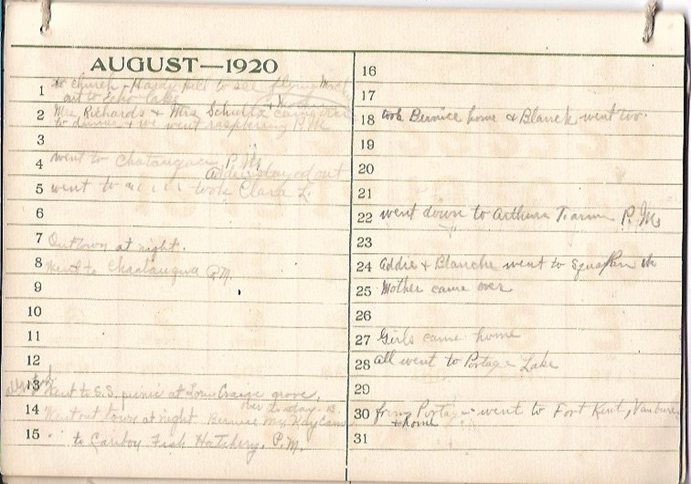
Figure 1. August, 1920, from the diary of Amy Richardson Sweetser, kept on a calendar with a day minder page below the dates. Courtesy of Wayne & Pamela Snow Sweetser collections.

Setting, Method
In 1920, Aroostook County had cars on the roads, but horses remained the premiere power for the dominant industries of farming and logging. A rural place that
identified anywhere beyond the County line as “Outside,” [2] Aroostook was, paradoxically, keenly eager for all the latest Outside offered–everything from farm machinery to ladies’ fashions–and it was surprisingly cosmopolitan in its commercial mentality and cultural priorities. Trains brought north an astonishing array of visitors from Temperance speakers, to circuses and peddlers, to annual Chautauqua Assemblies such as the one Amy and her family enjoyed in August. Figure 3 map identifies their favorite lakes for camping.[3]
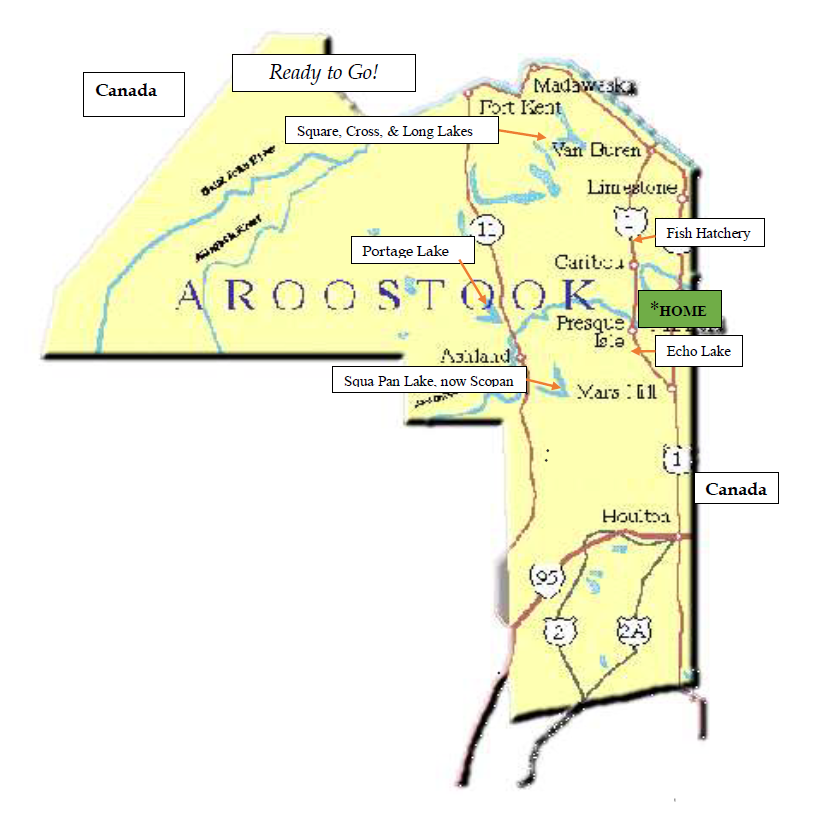
Since the 1970’s, personal narrative theorists and feminist scholars have explored and defined methodologies for using women’s diaries as historical evidence, and as discrete histories in themselves. This ongoing work underscores that reading diaries is a nuanced interplay between the woman who kept the diary and the historian who attempts to understand what is, and what is not, written. More importantly, the experts have given us words and ways to think and talk about women’s diaries. When I study diaries, I am mindful of the following:
- Feminist geography and the influence of place;
- Temporal elements–the duality of timeespecially–what Margo Culley calls the “eternal present” where slipping into the diaries makes the past seem like the present;
- The so-called “I’s” of a diary wherein the woman who keeps the diary is subject, writer/author, and reader of her own records;
- The pasts of ordinary people matter;
- Regardless of which fields, theories, or methods historians use, the essential form of history is a story, a narrative which becomes written history, even though we never know the full “reality” of the past.[4]
Diaries Transcribed: August 1920
I have divided the month into three segments separated with “Between the Lines” interludes and images. All fifteen of Amy’s entries are transcribed in italics, followed by selections from Addie’s which indicate day of the week and corroborate or elaborate on Amy’s.
August 1-3, 1920
- to church out to Echo Lake—Hardy Hill to watch flying machines
Sun. Fine. Went to Church, Sunday school, and to Lizzie’s [Amy’s sister] to dinner. Then up river for lilies & out to cemetery. Amy’s folks went to Hardy hill to watch the flyers then to Echo Lake.
2. Mrs. Richards & Mrs. Schultz & Mother came over to dinner & we went
raspberrying p.m.
Mon. Fair. Amy came & washed & took Mrs. Richards, Schultz & I over home & girls had a nice dinner. All went raspberrying P.M.
3. Tue. I staid [sic] over and helped put up raspberries. Amy & I rode over to see potatoes and up to the other place [Sweetser farmland about ¾ mile away] at night. Haying some & boys help a lot.
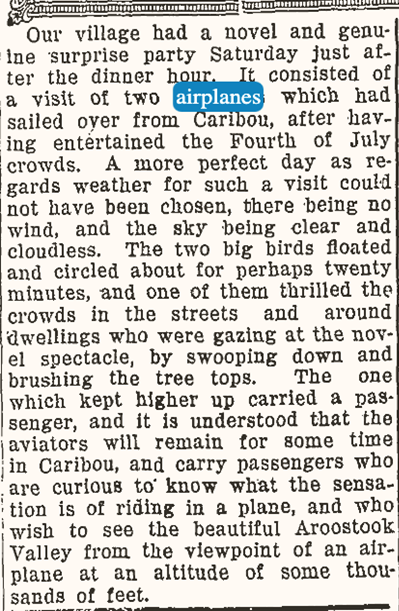

Photograph courtesy Dr. Richard Graves and Dr. Gary Boone, Presque Isle, Maine.
Between the Lines
August was off to a pleasant start for the family who went a second time to see the flying machines on Hardy Hill. According to Presque Isle’s weekly newspaper, the Star-Herald, barnstormers were causing quite a stir zooming about and carrying passengers aloft.[5] Hot, dry weather allowed haying to finally finish up, and Amy enjoyed company and help with the raspberries. For the boys, the best time was going to Echo Lake to cool off.
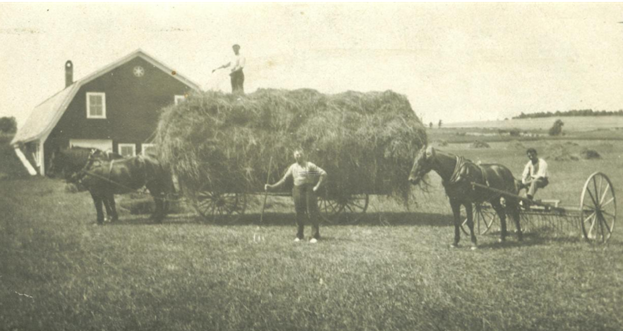
Courtesy Maine Memory Network and the Olof O. Nylander collection, samlat (display card) 13.
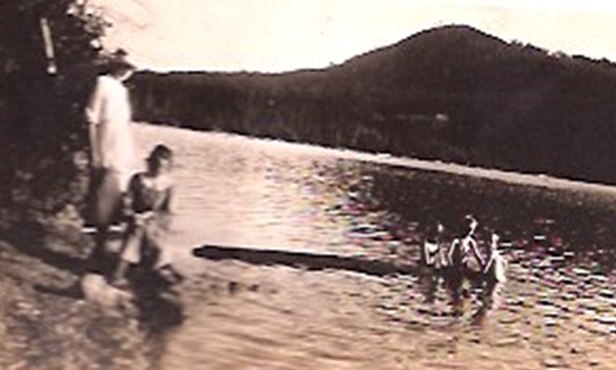
August 4-8
4. went to Chautauqua P.M. Addie stayed out
Wed. Fine. Amy, girls & I came home P.M. They to Chautauqua. Alice, Myron, Mother Gartly & Mrs. Pitt Cook called.
5. went to ” ” ” [Chautauqua P.M. ] Took Clara L
Thu. Fine. swept & dusted as Hattie Conant, Erma Hopkinson, & May Boynton came and spent the P.M. Amy & girls went to Chautauqua. I went with Mrs. Richards in evening. Addie visited Normal School.
6. Fri. Fine & so Dusty. Addie staid over & Lizzie & Nina called P.M. Amy & Girls went to Chautauqua P.M. I went in evening. Addie went home & Blanche stayed
7. Out town at night.
Sat. Hot. Dusty. Blanche staid over & we cleaned up & cooked a little. Amy came with boys and they went to Chautauqua. I lay down an hour. Called to see Mrs. Tracy. Blanche & I went to Chautauqua evening.
8. went to Chautauqua P.M.
Sun. Hot. went to Church and Chautauqua. Amy & family brought dinners and went too. Mr. & Mrs. Forbes called. Alice & family called. Wrote to Eva.

Between the Lines
The Community Chautauqua was an event of high value to Amy Sweetser who had grown up attending and participating in encampments and Chautauquas. Months in the planning, the 1920 Presque Isle Community Chautauqua attracted huge crowds to enjoy five days of distinguished lectures, theater, music, and other cultural and spiritual enlightenment. Included was a daily Junior Chautauqua program.
The star attraction, proclaimed the Star Herald on July 1, 1920, was “the well known play of American life, “Polly of the Circus”. . . in itself an event of extraordinary interest, especially as 1920 has been a year during which people have been asked to encourage everything which is strictly American—be it in any walk of life. . . .”[6] Perhaps the nudge toward patriotic duty helped justify the expense and time spent in the midst of summer harvests. Theater was one of Amy’s personal passions (see Figure 14). Trains carried repertory theater companies to every corner of the country where they performed Broadway hits like Polly of the Circus in their “canvas playhouses.”[7]
Chautauqua, an offspring of the 19th c Lyceum Movement and summer Methodist-Episcopal Sunday School Institutes, originated in 1871, on the shores of Lake Chautauqua in Chautauqua, New York. The Chautauqua movement, still operating today, took off across America in the form of hundreds of Independent and Circuit Chautauquas that reached their zenith by the 1920s. These Tent Chautauquas were summer features in counties across the country, promoting the organization’s commitment to lifelong learning, interdenominational religion, scientific thought, social reform, music, theater, oration, art, and wholesome outdoor family recreation.[8]
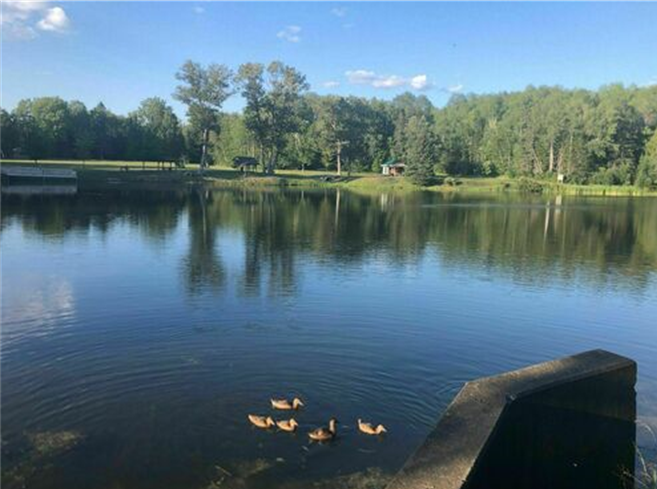
Photo Courtesy alltrails.com and mainetrailfinder.com.
Except for a reference to “Southeast Presque” neither the diaries nor the Star Herald specify exactly where the Chautauqua Assembly set up. The most probable site was Mantle Lake Park. It was an ideal setting with grassy expanses near water and surrounded by Mother Nature.[9] The whole month of July the Chautauqua management waged an advertising blitz in the Star Herald that drew huge crowds to “the big brown tents.”[10]
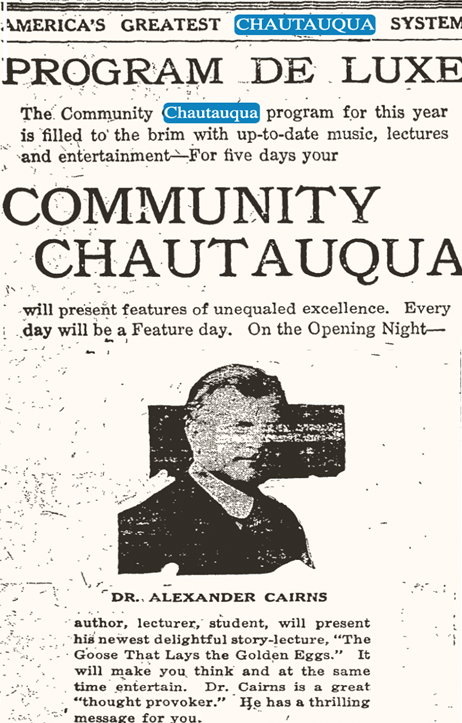
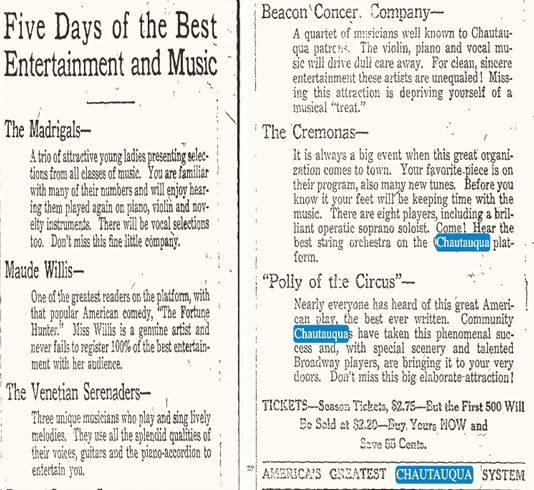
Courtesy Digital Archives, Mark & Emily Turner Memorial Public Library, Presque Isle, Maine.



August 9-27
9. Mon. Hotter Washed a little . . . Helped Mrs. Schultz fix peas to can. . . .
10. Tue. Hotter yet. Heavy Showers P.M. Amy came and washed. Did shopping between showers. . . .Mrs. Schultz is doing a lot of canning. [as was Amy]
11. Wed. Warm. Dull Rain at night. . . .
12. Thu. Dull wet
13. all but dad went to S.S. picnic at Lorin Craige grove
Fri. Dull A.M. Fine P.M. . . . Amy came got her clothes. I went with Lizzie to SS Picnic at Craig’s grove downriver
14. went out town at night Bernice McKay came over to stay—B. [with Blanche]
15. to Caribou fish hatchery. P.M.
Sun. Sun & Shade. Amy & girls met to Church then all went to Caribou to Fish Hatchery. I lay in hammock most all day feeling badly in stomach & bowels. Lizzie called.
16. Mon. Fair warm . . . .
17. Tue. Hot so hot. Amy came and washed A.M. & went down town P.M. I rode down to Lizzie’s with her. They expect Helen’s young man & will then go to Squ Pan [sic].
18. took Bernice home & Blanche went too [11]
Wed. Fine Cool Helen & Bennie Price called A.M. Dorothy came Ironed, cleaned rugs & Lizzie came. P.M. Mrs. Tracy called. Amy brought some cream took Bernice & Blanche to McKays. Lizzie brought me some buttermilk at night.
19. Thurs [combined with Wednesday, apparently]
20. Fri. Fine Lizzie brought me chicken stew and water lilies. Her Girls started for Squ Pan. Amy & Addie went to Cemetery & did some shopping P.M. I canned 5 pts. beens [sic]
21. Sat. Colder Windy. Feel weak. Slept good. Lay in Hamock [sic] P.M. Mr. McCaughy called. Mr. Wood bought the tenement and wants sewer connection with us. Amy & Addie, Alma & Nellie Potter called went down Town.
22. went down to Arthur’s Farm P.M.
Sun. Showers afternoon and evening. Amy & family came to church & took their dinners. E[lvin] all went to Lizzie’s & over to see Nina’s home. Nina telephoned they got to Squ Pan & were all well. Blanche went to Grand Falls with McKays.
23. Mon. Fair cool Feeling better. Wiped some dust. Amy & Addie came to wash. Canned 3 pts. beens. Mrs. Estes called & got some yeast of Amy. . . . .
24. Tue. Fine Amy brought girls who took the 11 o clock train with Nellie & Alma Potter for Squ Pan. I went home with Amy. Lois’ party came from Squ Pan.
25. Mother came over
Wed. Fine. Lots of harvesting being done. Am helping Amy some.
26. Thu. Fine
27. Girls came home
Fri.[marked Sat but actually Fri] Fine. Amy churned 13 ½ lbs. We came out and got the girls, who had a fine time at the Lake. I staid home Elizabeth Jenkins called.
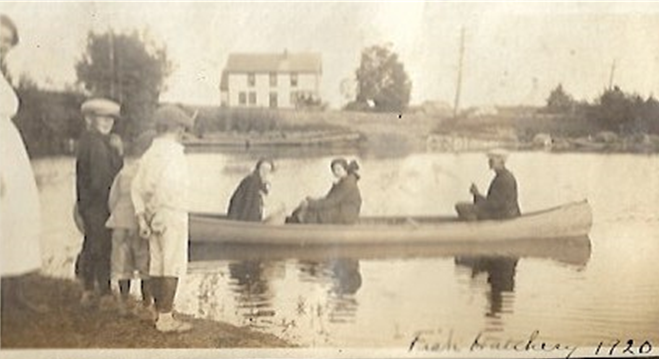
Between the Lines
Chautauqua ended and Amy was behind a day with laundry. Garden harvest piled up to be processed, butter had to be churned, and five children needed her attention. Still, she kept up with church, Sunday School picnics, and cemetery visits.[12] The family went canoeing at the Fish Hatchery, the daughters went off with friends as well as to Squa Pan Lake (today Scopan) with their cousins.[13] In all likelihood Amy, not Elvin, arranged for the upcoming camping trip to Portage Lake. As is usual, throughout both women’s diaries, they make minimal mention of the boys.
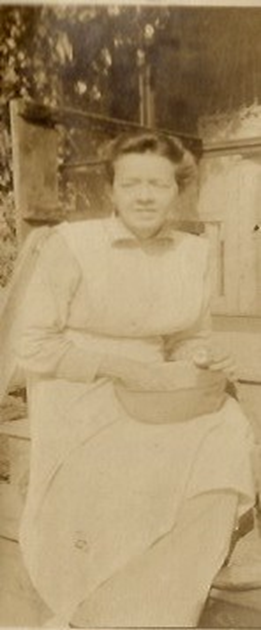
Courtesy Wayne and Pamela Snow Sweetser Collections.
August 28-31
28. All went to Portage lake
Sat. Hot Dorothy mowed the lawn. Amy & family went to Portage Lak [sic]. Called to Mrs. Pomroys and Esteys.
29. Sun. Warm Went to Church & Sunday school. . . .
30. from Portage went to Fort Kent, Van buren, & home
Mon. Warm showers. . . Amy’s folks got home from Portage by way of Fort Kent.
31. Tue. Sun & shade Rain night . . . .
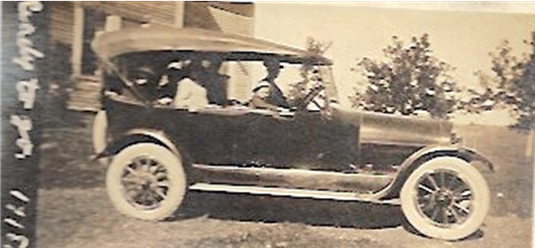
Between the Lines
Portage Lake, with its magnificent sporting lodges and well-appointed camps, has been a big game hunting and fishing destination since the 1830s. Shoreline cottages and boat rentals, as well as numerous small beaches made it a popular destination for family tenting, boating, fishing, and swimming. A 35-mile drive west of Presque Isle, it was one of the Sweetsers’ favorite lakes.

Courtesy Wayne and Pamela Snow Sweetser Collections.

Courtesy Wayne and Pamela Snow Sweetser Collections.
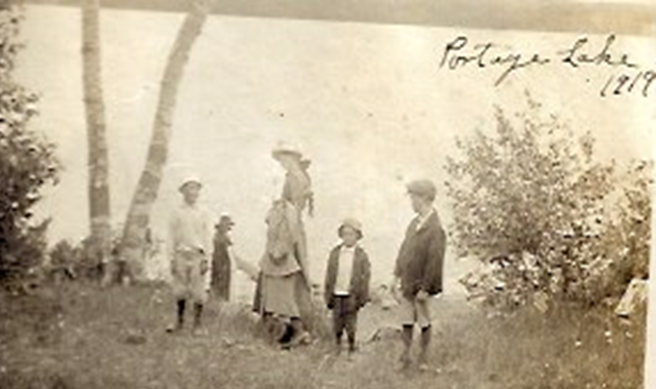
Courtesy Wayne and Pamela Snow Sweetser Collections.
Women & Leisure
The United States 1930 census had a classification “housewives not gainfully occupied” that included 21.3 percent of the population. Women’s domestic work was not regarded as an occupation and thereby produced no gain. Women who drove children to the river for a swim and a picnic or who took them for long weekends at the lake were definitely not considered to be engaged in any type of work. Preparation of food and gear, mindfulness for child safety, supervising and serving food on the outing, driving home and cleaning up after were regarded as part of the fun and relaxation such an outing brought to the family.
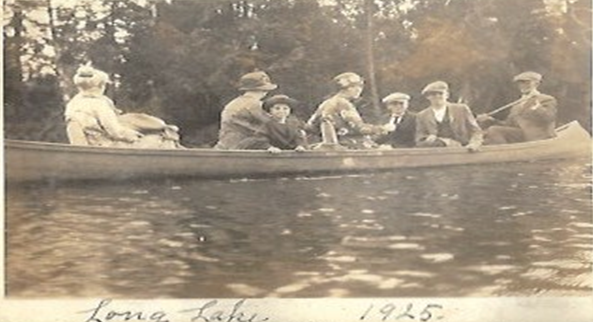
Courtesy Wayne and Pamela Snow Sweetser Collections
Which is not to argue that Amy and other mothers despised outdoor recreation with their families. Quite the contrary, they could fill a picnic basket in a jiffy, organize and load up kids, and be off, glad for a change. The Sweetsers invested plenty of money and effort in leisure time with their children. In the 1920’s especially, family friends (parents and children) joined up to rent cabins on lakes around the County.
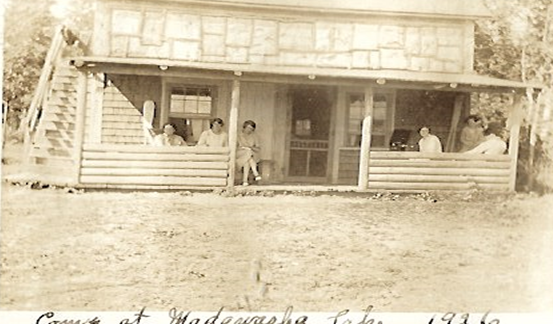
The habit of “going to camp” became generational. Though not as inclusive as it once was, some family members still co-own and share a camp on Scopan Lake that was passed down from Elvin and Amy’s twin sons, Ralph and Richard. All-season gatherings there have produced some fine memories reminiscent of those preserved below in family photo albums from nearly a century ago.

Figure 23. Goofy girls at Madawaska Lake, 1926. Blanche on right with one of her girlfriends.
Courtesy Wayne and Pamela Snow Sweetser Collections.

Figure 24. Bathing beauties at Cross Lake, 1927. A playful weekend with families again sharing a large camp. Courtesy Wayne and Pamela Snow Sweetser Collections.

Figure 25. “Girls Just Wanna Have Fun!” Notice the legs–long enough to be Addie Junior’s; canoeing with a girlfriend on Cross Lake, 1927. Courtesy Cyndi Lauper’s hit single, “Girls Just Want to Have Fun,” 1983; music and lyrics by Robert Hazard, 1979.
[1] The older set from Adwina (Addie) O’Brien Richardson (1851-1941) are in the possession of Miriam Gregg, who has generously allowed me to make use of them. The second set from Addie’s daughter, Amy Richardson Sweetser (1876-1958) are in the possession of my husband, Wayne Sweetser, who has granted me unlimited access and use of them.
[2] The “Outside” designation persists today.
[3] David Rumsey Historical Map Collection, Rand McNally, Maine 1924, https://www.davidrumsey.com/luna/servlet/detail/RUMSEY~8~1~201521~3000576:Maine- https://www.oldmapsonline.org/?; “The Maine Way,” http://www.mainerec.com/roostook.asp?Category=203&PageNum=203; Randy Mallory, “Tent Shows” December 2018, accessed August 1, 2021, https://www.texascooppower.com/texas-stories/history/tent-shows; Theatre Museum of Repertoire Americana,
https://www.oldthreshers.org/museums/theatre-museum-of-repertoire-americana/
[4] Selected references that have informed my studies; by no means an exhaustive list.
Suzanne Bunkers and Cynthia A. Huff, eds., Inscribing the Daily, Critical Essays on Women’s Diaries (Amherst: University of Massachusetts Press, 1996); David Carr, Time, Narrative, and History (Bloomington: Indiana University Press, 1986); Margo Culley, ed., A Day at a Time: Diary Literature of American Women from 1764 to the Present (New York: Feminist Press, 1985); Mona Domosh, Joni Seager, Putting Women in Place, Feminist Geographers Make Sense of the World (New York: The Guilford Press, 2001); Judy Long, Telling Women’s Lives, Subject/Narrator/Reader/Text (New York: New York University Press, 1999); Elliot G. Mishler, “Models of narrative Analysis: A Typology,” Journal of Narrative and Life History, 5/2 (1995): 87-124; Pamela Moss, ed. Feminist Geography in Practice, Research and Methods (Malden, MA: Blackwell Publishers Ltd., 2002); James Olney, ed. Studies in Autobiography (New York: Oxford University Press, 1988); Sidoni Smith, & Julia Watson, Reading Autobiography, A Guide for Interpreting Life Narratives (Minneapolis: University of Minnesota Press 2001); Penny Summerfield, Histories of the Self: Personal Narratives and Historical Practice (New York: Routledge, 2019); Alex Winder, “Nakba Diaries: Unsettling the Scale and Temporality of Historical Writing.” Al Muntaqa 2, no. 2 (2019): 24-39. Accessed July 26, 2021. doi:10.31430/almuntaqa.2.2.0024.
[5] Presque Isle Star-Herald, July 15-August 5, 1920. Courtesy Digital Archives, Mark & Emily Turner Memorial Public Library Presque Isle, Maine. My most useful and willing source for finding rare photographs is Dr. Richard Graves, Presque Isle optometrist and historian. A Google search yields quick information on the Curtis JN-4 (Flying Jenny) and barnstorming, all the rage in the 1920’s.
[6] The Presque Isle Star Herald, July 1, 1920, p. 11. Digital Archives, Mark & Emily Turner Memorial Public Library, http://turner.advantage-preservation.com/.
[7] Polly of the Circus, a 3-act play blending “humor, pathos and melodrama, and spectacular stage business” opened a strong Broadway run in 1907. In 1908 it went on the road, and was made a movie in 1917. “Tales from a Scenic Artist and Scholar. Part 598: – Polly of the Circus,” https://drypigment.net/2018/12/19/tales-from-a-scenic-artist-and-scholar; “Tent Shows” by Randy Mallory, December 2018, https://www.texascooppower.com/texas-stories/history/tent-shows; Theatre Museum of Repertoire Americana, https://www.oldthreshers.org/museums/theatre-museum-of-repertoire-americana/; “Polly of the Circus (1907 play),” https://en.wikipedia.org/wiki/Polly_of_the_Circus_(1907_play);
[8] “Chautauqua: Educating Rural America,” July 2014, beyondboulder.com, http://www.beyondboulder.com/blog-beyond/2014/7/23/the-chautauqua-movement; Andrew C. Rieser, The Chautauqua Moment Protestants, Progressives, and the Culture of Modern Liberalism. NY: Columbia University Press. 2003.
[9] The best man for solving local history “mysteries” is Dr. Richard Graves; we aren’t certain, but his deduction is sound. Presque Isle Recreation and Parks Department https://www.pirec.org/facilities-and-parks/mantle-lake-park.html; Mark & Emily Turner Memorial Public Library https://www.pimainelibrary.org/
[10] “The Sprague’s Mills Road Carnival,” a tongue-in-cheek report covering a well-attended hearing on the Trunk Line Road proposition facetiously suggested the planners should have requested the use of Chautauqua “big brown tents” to accommodate the crowd. The Presque Star Herald, July 8, 1920.
[11]No mention of the 19th amendment ratified on August 18, 1920, though typically neither Addie nor Amy had much to say about politics in their diaries.
[12] In rare diary moments Amy confesses to being “lonesome.” Probably a state of melancholy we call “depression” today. Addie used the same term and had debilitating episodes with it. It is reasonable to assume the death of Louis, her youngest son, troubled Amy long after his passing in 1918. The extended family had a well-established tradition of honoring their dead with regular cemetery visits to attend grave sites and place flowers of remembrance. Among their favorites were forget-me-nots.
[13] The lake name Amy and Addie used was officially changed ten years ago. “Squa” is offensive to Native American women, yet it took a century after the diaries were written to finally change the name of 6 locations in Maine bearing the insulting word. “Six Aroostook County locations renamed to remove racial slurs,” Bangor Daily News, September 9, 2011, https://bangordailynews.com/2011/09/05/.
